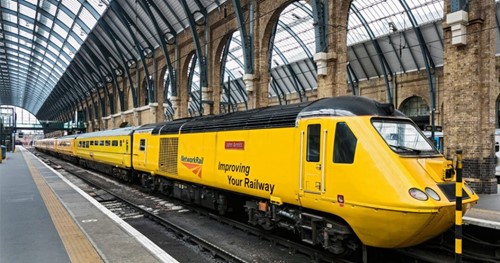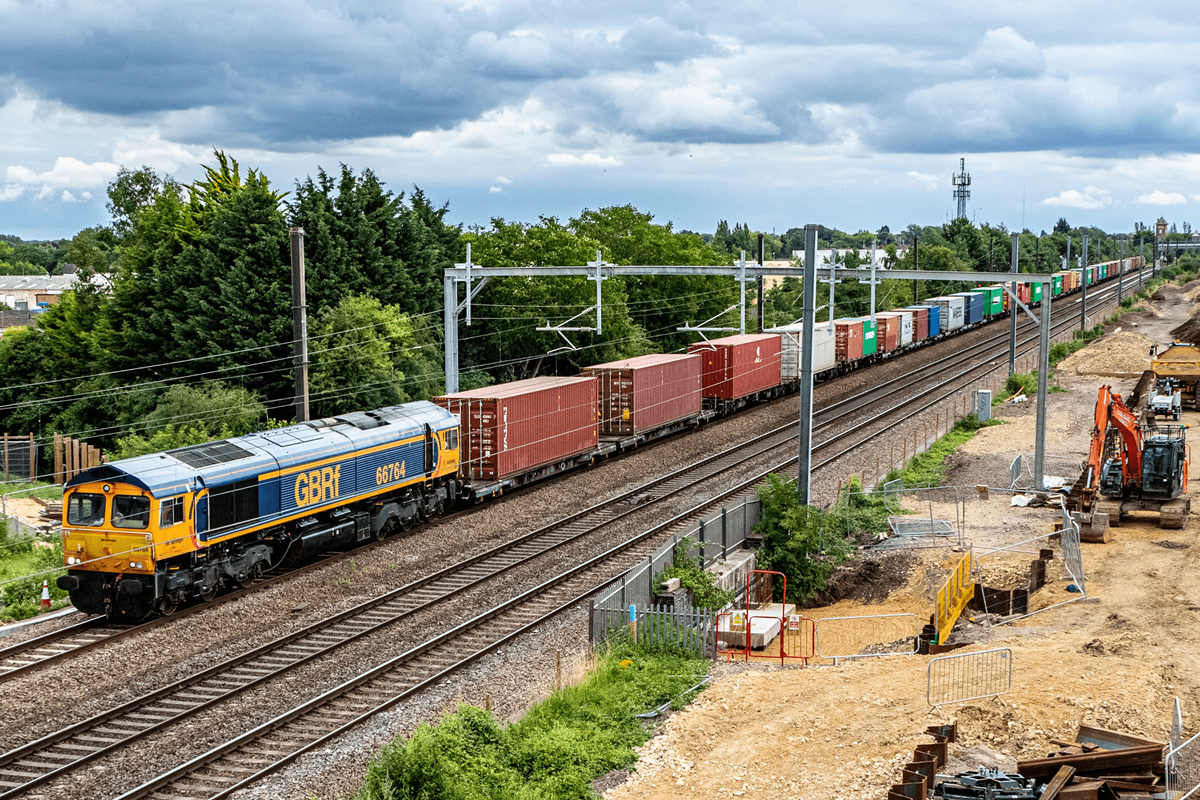Affectionately known as the ‘Flying Banana’, this bright yellow High Speed Train has been one of the most eye-catching trains on Britain’s railways for the last 15 years. But the New Measurement Train is more than just eye candy. It absolutely bristles with technology and plays a vital role on the railway.
So, why is the NMT so important? Anyone remember a maths lesson where you were taught the ‘distance, speed, time’ triangle? Being able to travel at 125mph means that the NMT can assess more track in a single operating session than any other train. And that’s incredibly useful if you have over 20,000 miles of railway to maintain to the highest standards.
Some of the NMT’s stats boggle the mind. It covers 115,000 miles in a year and will capture around 10TB of image data every 440 miles.
Even at high speed, a laser sensor gives information about the profile of the rail head, measuring shape and movement optically. At the same time transducers and accelerometers mechanically measure the up and down movement of the train as it travels along the rails. This data provides information on track geometry - the shape and profile of the rail head, and the twist of the track.
NMT’s plain line pattern recognition (PLPR) system uses a series of lasers and cameras to detect faulty track components as the train passes over them. Image analysis software uses an algorithm to compare what the cameras see with an image of how the track should look. It’s so accurate that it can identify missing Pandrol clips.
Normally, the NMT is off-limits to all but a privileged few. However, Network Rail proudly opened this remarkable train up for Rail Live 2021 guests (face masks were worn on board). In addition, there were displays about how the NMT works and its role on the network, guests also had the opportunity to talk to those who worked on it.

Class 66 forms the backbone of GBRf’s locomotive fleet. This EMD diesel-electric is versatile enough to handle any job, from heavy stone trains to permanent way duties. After acquiring its first in 2001, GBRf now has 94 Class 66s, including the very last to be built and soon will be 99 with additional 66’s coming into service shortly..
GBRf’s close links to the military have been cemented through various locomotive namings and two of those commemorative ‘66s’ are on show at Rail Live 2021 as part of a very special military display.
Topping the bill is 66715 Valour. The nameplate carried by this locomotive mimics those which the Great Central Railway famously bestowed upon ‘9P’ 4-6-0 (LNER ‘B3’) No. 1165 after the First World War. Whilst 66715 was named on November 11 (2003), there’s one key difference: GBRf’s Valour commemorates all British Railway servants who gave their lives for their country and not just those who worked for the GCR.
Alongside 66715 is 66723 Chinook. This locomotive commemorates the famous twin rotor helicopters flown by 7, 18 and 27 Squadrons at RAF Odiham. There is a wealth of detail on this locomotive: the nameplate carries the three squadron crests, there’s a stylised Chinook logo on both sides plus a pseudo RAF serial number which combines the ‘ZA’ of the Chinook HC1 fleet and the locomotive’s number.
Last but not least is 66764. The locomotive is one of the final batch of ‘66s’ to be delivered from the US and it arrived in Britain on September 7 2014. This locomotive is attending Rail Live 2021 in order to receive a very special name that will further tie the railway and the military together.

It’s natural that the motive power grabs the attention, but you can’t move huge amounts of freight without the wagons that follow the locomotive. And GBRf is showing off three that reflect the wide variety of materials that it moves on a daily basis.
The newest vehicle is the IIA bogie sand hopper built by Greenbrier Poland. These 41 vehicles replaced aging four-wheel PAA on sand trains from Middle Towers, near King’s Lynn. They carry more sand and can run at higher speeds than their predecessors.
Biomass, the natural fuel substance that is replacing coal in our power stations, is an important source of revenue for GBRf. It took delivery of 50 new Polish-built IIA biomass hoppers in 2017 to supply Lynemouth Power Station in Northumberland.
And lastly, the JNA-T ‘Ealnos’ bogie box wagon. These vehicles, built by Astra Rail in Romania, are used by GBRf on aggregates traffic for customers such as Tarmac and Hanson and can be seen from Cumbria to Kent.
Demo times:
Wed
Thursday
When the venerable ex-London Transport ‘1938 Stock’ was withdrawn from the Isle of Wight in January 2021, the baton of ‘Britain’s oldest passenger train fleet’ passed to Merseyrail. Its 70-odd route miles of track are still playing host to Class 507s and 508s, the youngest of which is 40 years old.
But Merseyrail’s tenure of said baton will be brief, for waiting in the wings is a fleet of 53 brand new four-car EMUs bristling with technology. Say hello to the Class 777.
These EMUs have been built by Swiss train builder Stadler. They have been designed to take power from either 750V DC third-rail or 25kV catenary and have an option to additionally be powered by 25kV catenary. The unit on show is fitted with a prototype battery system which enables it to travel beyond Merseyrail’s 3rd rail and to recycle braking energyUnlike the EMUs they’re planned to replace, the ‘777s’ have been built to take maximum advantage of Merseyrail’s loading gauge.
The ‘777s’ look set to transform Merseyrail’s operations. They can carry more passengers than the old three-car BR units, they’re quicker and they’re lighter too, which means less damage to the permanent way. They’re also more efficient and promise a 20% reduction in energy use which could be further increased if the battery technology is adopted.
It’s anticipated that the ‘777s’ will enter regular service shortly. And, in time, additional sets could be added to the fleet as Merseyrail looks to expand its network.